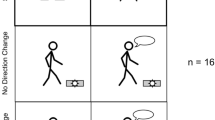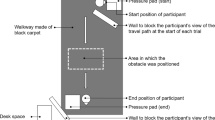Abstract
Carrying an anterior load during obstacle negotiation increases attention demand, which may differ at various crossing stages. Less is known on the impact of lower visual field obstruction and the weight of the anterior load on obstacle negotiation and attention demand. The objectives of this study were to: (1) determine if carrying a weighted anterior load, lower visual field occlusion, or both, modify obstacle clearance and/or reaction time (RT); and (2) examine whether RT is modulated across obstacle crossing phases as measured by a probe RT protocol. Sixteen young adults crossed an obstacle while carrying no load, a clear 5 kg load, and an opaque 5 kg load, while performing a simple RT task. Auditory stimuli were presented at five locations: (1) two steps before the obstacle; (2) one step before the obstacle; (3) as the leading limb crossed the obstacle; (4) as the lead limb touched down after the obstacle; and (5) as the trail limb crossed the obstacle. The toe clearance height of the leading limb was greatest for the weighted opaque box load type followed by the weighted clear box type compared to the no box load type. Carrying an anterior load during obstacle crossing did not influence RT. RTs were longer at the pre-crossing and beginning of the crossing phases compared to after-crossing phases. Results suggest that carrying a weighted anterior load and lower visual field occlusion increase the risk for tripping. Attention demands differ across obstacle crossing phases during dual-tasking and should be considered in fall-risk assessments.



Similar content being viewed by others
References
Austin GP, Garrett GE, Bohannon RW (1999) Kinematic analysis of obstacle clearance during locomotion. Gait Posture 10(2):109–120
Berard JR, Vallis LA (2006) Characteristics of single and double obstacle avoidance strategies: a comparison between adults and children. Exp Brain Res 175(1):21–31
Brown LA, McKenzie NC, Doan JB (2005) Age-dependent differences in the attentional demands of obstacle negotiation. J Gerontol 60(7):924–927
Bryant DJ, Tversky B (1999) Mental representations of perspective and spatial relations from diagrams and models. J Exp Psychol Learn Mem Cogn 25:137–156
Buckley JG, Timmis MA, Scally AJ, Elliott DB (2011) When is visual information used to control locomotion when descending a kerb? PLoS One 6(4):e19079
Chen HC, Ashton-Miller JA, Alexander NB, Schultz AB (1991) Stepping over obstacles: gait patterns of healthy young and old adults. J Gerontol 46(6):196
Chen HC, Schultz AB, Ashton-Miller JA, Giordani B, Alexander NB, Guire KE (1996) Stepping over obstacles: dividing attention impairs performance of old more than young adults. J Gerontol 51:116–122
Diaz GJ, Parade MS, Barton SL, Fajen BR (2018) The pickup of visual information about size and location during approach to an obstacle. PLoS One 13(2):e0192044
Fraizer EV, Mitra S (2008) Methodological and interpretive issues in posture-cognition dual-tasking in upright stance. Gait Posture 27(2):271–279
Franklin N, Tversky B (1990) Searching imagined environments. J Exp Psychol Gen 119:63–76
Harley C, Wilkie RM, Wann JP (2009) Stepping over obstacles: attention demands and aging. Gait Posture 29(3):428–432
Hawkins KM, Perry CJ, Kiriella JB, Shanahan CJ, Moore AE, Gage WH (2011) Attentional demands associated with obstacle crossing while carrying a load. J Mot Behav 43(1):37–44
Jeannerod M (2003) Action monitoring and forward control of movements. In: Arbib Michael (ed) The handbook of brain theory and neural networks, 2nd edn. MIT Press, Cambridge, pp 83–85
Jehu DA, Lajoie Y, Paquet N (2018) Improvements in obstacle clearance parameters and reaction time over a series of obstacles revealed after five repeated testing sessions in older adults. Mot Control 22(3):245–262
Kahneman D (1973) Attention and effort, vol 1063. Prentice-Hall, Englewood Cliffs
Kunimune S, Okada S (2019) Contribution of vision and its age-related changes to postural stability in obstacle crossing during locomotion. Gait Posture 70:284–288
Lajoie Y, Teasdale N, Bard C, Fleury M (1993) Attentional demands for static and dynamic equilibrium. Exp Brain Res 97(1):139–144
Marigold DS, Patla AE (2007) Gaze fixation patterns for negotiating complex ground terrain. Neuroscience 144(1):302–313
Mohagheghi AA, Moraes R, Patla AE (2004) The effects of distant and on-line visual information on the control of approach phase and step over an obstacle during locomotion. Exp Brain Res 155(4):459–468
Muir BC, Haddad JM, van Emmerik REA, Rietdyk S (2019) Changes in the control of obstacle crossing in middle age become evident as gait task difficulty increases. Gait Posture 16(70):254–259
Overstall PW, Exton-Smith AN, Imms FJ, Johnson AL (1977) Falls in the elderly related to postural imbalance. Br Med J 1(6056):261–264
Patla AE, Greig M (2006) Any way you look at it, successful obstacle negotiation needs visually guided on-line foot placement regulation during the approach phase. Neurosci Lett 97(1–2):110–114
Patla A, Rietdyk S (1993) Visual control of limb trajectory over obstacles during locomotion: effect of obstacle height and width. Gait Posture 1(1):45–60
Patla AE, Vickers JN (1997) Where and when do we look as we approach and step over an obstacle in the travel path? Neuroreport 8(17):3661–3665
Perry CJ, Kiriella JB, Hawkins KM, Shanahan CJ, Moore AE, Gage WH (2010) The effects of anterior load carriage on lower limb gait parameters during obstacle clearance. Gait Posture 32(1):57–61
Rhea CK, Rietdyk S (2007) Visual exteroceptive information provided during obstacle crossing did not modify the lower limb trajectory. Neurosci Lett 418(1):60–65
Rietdyk S, Rhea CK (2006) Control of adaptive locomotion: effect of visual obstruction and visual cues in the environment. Exp Brain Res 169(2):272–278
Rietdyk S, McGlothlin JD, Williams JL, Baria AT (2005) Proactive stability control while carrying loads and negotiating an elevated surface. Exp Brain Res 165(1):44–53
Sholl MJ, Nolin TL (1997) Orientation specificity in representations of place. J Exp Psychol Learn Mem Cogn 23:1494–1507
Siu KC, Catena RD, Chou LS, van Donkelaar P, Woollacott MH (2008) Effects of a secondary task on obstacle avoidance in healthy young adults. Exp Brain Res 184(1):115–120
Sparrow WA, Bradshaw EJ, Lamoureux E, Tirosh O (2002) Ageing effects on the attention demands of walking. Hum Mov Sci 21(5–6):961–972
Timmis MA, Buckley JG (2012) Obstacle crossing during locomotion: visual exproprioceptive information is used in an online mode to update foot placement before the obstacle but not swing trajectory over it. Gait Posture 36(1):160–162
Wolbers T, Hegarty M (2010) What determines our navigational abilities? Trends Cogn Sci 14(3):138–146
Woollacott M, Shumway-Cook A (2002) Attention and the control of posture and gait: a review of an emerging area of research. Gait Posture 16(1):1–14
Worden TA, Vallis LA (2016) Stability control during the performance of a simultaneous obstacle avoidance and auditory stroop task. Exp Brain Res 234(2):387–396
Worden TA, De Jong AF, Vallis LA (2016) Do characteristics of a stationary obstacle lead to adjustments in obstacle stepping strategies? Gait Posture 43:38–41
Yogev-Seligmann G, Hausdorff JM, Giladi N (2008) The role of executive function and attention in gait. Mov Disord 23(3):342
Funding
This study received no funding.
Author information
Authors and Affiliations
Corresponding author
Ethics declarations
Conflict of interest
The authors have no conflict of interest to declare.
Additional information
Communicated by Melvyn A. Goodale.
Publisher's Note
Springer Nature remains neutral with regard to jurisdictional claims in published maps and institutional affiliations.
Rights and permissions
About this article
Cite this article
Jehu, D.A., Saunders, D., Richer, N. et al. The influence of carrying an anterior load on attention demand and obstacle clearance before, during, and after obstacle crossing. Exp Brain Res 237, 3313–3319 (2019). https://doi.org/10.1007/s00221-019-05673-1
Received:
Accepted:
Published:
Issue Date:
DOI: https://doi.org/10.1007/s00221-019-05673-1




